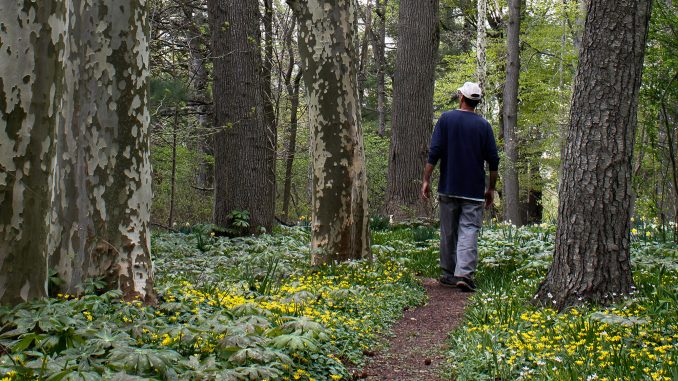
From 2006-09, Christopher Sohnly worked as a special projects landscaper for Gheel House, a residential mental health community located along French Creek.
Sohnly worked to clear a trail system that residents could use to walk the grounds, but when he returned in 2011, he saw that the trail systems had become unkempt, overgrown and no longer usable.
With encouragement from some of his mentors, professors Susan Mrugal and Eva Monheim, he decided he had to go back, not only to fix the trails, but to ensure that current and future residents would be able to enjoy them down the road.
“I had a friend of mine who was a Diamond Scholar in 2013, but I never for the life of me thought I would get it,” said Sohnly, a graduating senior in the department of landscape architecture and horticulture.
In 2014, Sohnly was awarded a $4,000 Diamond Scholarship, which has since allowed him to begin the process of reopening the trails to the residents and staff at Gheel House, but also to carefully document all of the ecosystems and buildings on the site.
“The whole idea [is to] document everything that is on the site and how it should be managed,” he said. “What problems there are, what strengths there are and what needs to be done to maintain them.”
Sohnly said Gheel House lies on very distinct topography in that the property has areas of both wetland and dry meadow, making it even more important to record and understand the landscape.
More important still, Sohnly said, is understanding the needs of Gheel House residents in creating an outdoor space where they can feel comfortable interacting with nature.
“It opens the doors for healing,” Sohnly said, of the resident’s access to the trails. “I know, for me, if I’m stressed to be able to go outside and see a bird or a plant – they call it positive distraction. I can only imagine what [it does] for these folks.”
Though Sohnly said he has not conducted any interviews with residents, through everyday interactions he has been able to see how the work he is doing is positively affecting them.
One resident, he said, was apprehensive when she found out Sohnly would be clearing some of the land to make room for the trails. But when she found out he would also be fixing up the goat house that lies on the property, she was thrilled.
“A week after we fixed up the [goat house] she came up to me and said, ‘Thank you for doing this work and for taking care of the goats,’” Sohnly said. “When I told the [doctors] about that they said that was huge. That she could connect to reality like that.”
Some of the residents, Sohnly said, especially those suffering from Schizophrenia, have a hard time connecting to the reality that most individuals experience. Though he said it is still important for him to talk with them and for them be an integral part of the restoration process.
In the future, Sohnly said he would like to be able to bring on a horticultural therapist and other experts to figure out how to better shape the environment into a center for relaxation and healing.
“More and more research is coming out saying [all people], let alone those with mental [illness], can benefit from green space,” said Eva Monheim, Sohnly’s mentor and a professor in the department of landscape architecture and horticulture. “It’s calming for the nerves and the mental well-being is measurable.”
The possibilities are endless, Sohnly said, in terms of how the residents and staff can interact with the trails and the environment. As of now he is still brainstorming and working to document the landscape so that future contractors will be able to keep in line with his original mission for the property.
“What’s important is that [I] do something so that whatever happens they will have documentation to carry the project forward,” Sohnly said. “[The residents] live there, some of them for years at a time, and they have this beautiful property, and it’s not accessible to them. So that’s what this whole project is about – making it accessible.”
Alexa Bricker can be reached at abricke1@temple.edu.



Be the first to comment